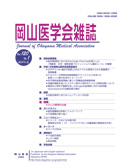

Journal of Okayama Medical Association
Published by Okayama Medical Association<Availability>
Full-text articles are available 3 years after publication.
Permalink : http://escholarship.lib.okayama-u.ac.jp/40691
Usefulness of avirulent strains in investigation of latent infection of herpes simplex virus type 1
Arao, Yujiro
Published Date
1990-12
Abstract
The usefulness of avirulent strains of herpes simplex virus type 1 (HSV-1) in investigations of latency was examined. Trigeminal ganglia (TG) latently infected with HSV-1 were obtained more efficiently from mice inoculated with an avirulent strain, SKO-1B, than from those inoculated with a virulent strain, F. Moreover, utilization of two avirulent strains, SKO-1B and -GCr Miyama, allowed us to compare the rate of reactivatable latency (RL) in these strains. Cultivation of explants of TG recovered from mice inoculated with the same dose of either infectious virus revealed a significant difference in the rate of RL between the two strains. Both strains were revealed to be neither hypersensitive nor resistant to acyclovir, indicating that the difference in the rate of RL between the two strains was not due to any deficient activity of viral ribonucleotide reductase and/or thymidine kinase. The recovery rate of the -GCr virus from explants of TG latently infected with this virus was greatly enhanced by treatment of the explants with sodium n-butyrate during in vitro cultivation. As such, at least one of the mechanisms responsible for causing a very low rate of RL in TG infected with -GCr Miyama may be reduced expression of immediate-early genes of this virus in latently infected cells in vitro.
Keywords
herpes simplex virus type 1
latent infection
reactivation
neurovirulence
ISSN
0030-1558
NCID
AN00032489
